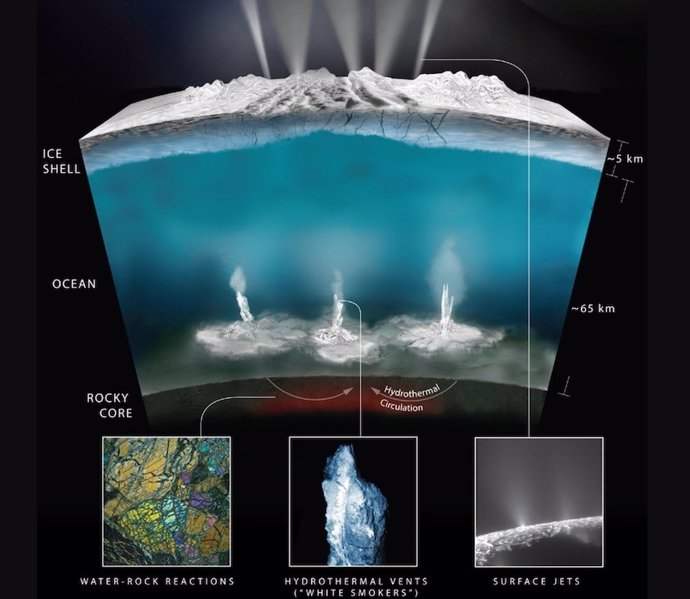Artist’s rendering of hydrothermal vents on the seafloor of the Saturnian moon Enceladus – NASA/JPL-CALTECH
June 28 () –
Hydrothermal vents that are common across the Earth’s seafloor may help create conditions conducive to life on the “ocean worlds” of our solar system.
It is the conclusion of a set of computer simulations of alien seabeds, carried out by scientists at the University of California Santa Cruz.
Ocean worlds are planets and moons that have (or had in the past) a liquid ocean, often under an icy shell or within their rocky interior. In Earth’s solar system, Several of the moons of Jupiter and Saturn are ocean worldsand its existence has motivated everything from peer-reviewed academic studies and satellite space missions, to popular films like the 2013 sci-fi thriller Europa Report.
Many lines of research suggest that some ocean worlds release enough heat internally to drive hydrothermal circulation beneath their seabeds. This heat is generated by radioactive decay, as occurs deep within the Earth, and possibly additional heat generated by the tides.
Fluid, heat, and rock systems were discovered on Earth’s seafloor in the 1970s, when scientists observed fluids discharging and transporting heat, particles, and chemicals. Many of the vent sites were surrounded by new ecosystems, including specialized bacterial mats, red and white tube worms, and heat-sensing shrimp.
In this new study, published in the Journal of Geophysical Research: Planets, the researchers used a complex computer model based on hydrothermal circulation as it occurs on Earth. After changing variables such as gravity, heat, rock properties, and the depth of fluid circulation, they found that hydrothermal vents could be maintained under a wide range of conditions. If these types of flows occur on an ocean world, such as Jupiter’s moon Europa, They could increase the chances that life exists there too.
“This study suggests that low-temperature hydrothermal systems (not too hot for life) could have been sustained on ocean worlds beyond Earth for timescales comparable to those required for life to become established on Earth,” he said. it’s a statement Andrew Fisher, lead author of the study and professor of earth and planetary sciences (EPS) at UC Santa Cruz.
The seawater circulation system on which the team based their computer models was found on a 3.5-million-year-old seafloor in the northwest Pacific Ocean, east of the Juan de Fuca mountain range. There, cold bottom water flows through an extinct volcano (seamount), travels underground for about 45 kilometers, and then flows back to the ocean through another seamount. “Water accumulates heat as it flows and comes out hotter than when it flowed in, and with a very different chemistry”explained Kristin Dickerson, second author of the paper and a doctoral candidate in earth and planetary sciences.
Flow from one seamount to another occurs by buoyancy, because water becomes less dense as it warms and more dense as it cools. Differences in density create differences in fluid pressure in the rock, and the system is sustained by the flows themselves, which operate as long as enough heat is supplied and the properties of the rock allow sufficient circulation of the fluid. “We call it a hydrothermal siphon,” Fisher said.
THE EARTH’S COOLING SYSTEM
While high-temperature vent systems are primarily due to subseafloor volcanic activity, Fisher explained that a much larger volume of fluid flows in and out of Earth’s seafloor at lower temperatures, driven primarily by cooling.” background” of the planet.
“The flow of water through the low-temperature vent is equivalent, in terms of the amount of water discharged, to all the rivers and streams on Earth, and is responsible for about a quarter of the Earth’s heat loss,” he said. “The entire volume of the ocean is pumped in and out of the seafloor approximately every half a million years.”
Many previous studies of hydrothermal circulation on Europa and Enceladus, a small moon orbiting Saturn, have considered higher-temperature fluids. Cartoons and other drawings often depict systems on their seafloors that resemble black vents on Earth, according to Donna Blackman, an EPS researcher and third author on the new paper. “Lower temperature flows are at least as likely to occur, if not more so,” said.
The team was particularly excited about a result from computer simulations included in the new paper showing that under very low gravity, such as that found on Enceladus’ seafloor, the circulation can continue at low to moderate temperatures for as long as possible. millions or billions of years.
This could help explain how small ocean worlds can have long-lived fluid circulation systems beneath their seafloors, even if warming is limited: the low efficiency of heat extraction could lead to considerable longevity, essentially, for the entire life of the solar system.















![[Img #74664]](https://thelatestnews.world/wp-content/uploads/2024/12/James-Watson-The-controversial-genius-behind-the-double-helix-300x200.jpg)
Add Comment